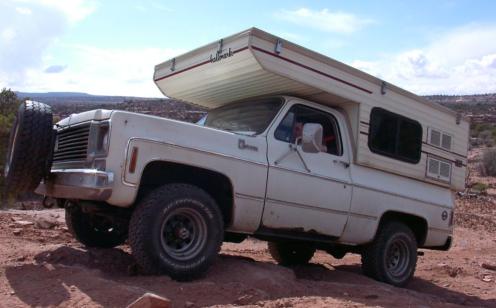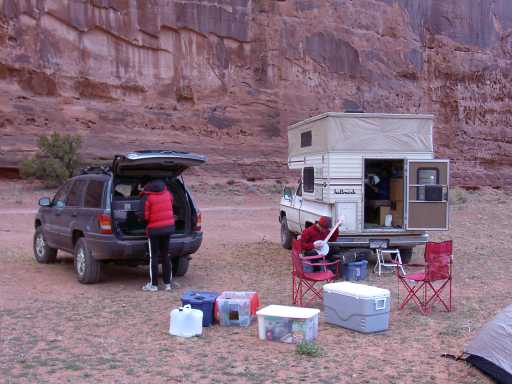***SOLD***: 1977 Chevy Blazer with Integrated Hallmark Camper
Simply put, this is an awesome vehicle that is hard to match at any price. It's rare to find this combination of a very livable camper and real 4x4 ability, and it's usually much more expensive to own.
What is this thing, exactly? It's a 1977 4x4 Chevy Blazer with an integrated 1994 Hallmark Pop-up Camper. That means that you can go from the cab to the camper part without going outside, and you can't (easily) take the camper off of the vehicle.
So, on to the specifics. I've done a lot of work on it, with plenty of help from others, of course. If I say something in here is "new," that means it's in the last year or so. I did most of the work in Spring/Summer 2003. |
|
 |
Near the Metal Masher loop off Gemini Bridges road, Utah
|
|
The Camper
The camper really is great. It's comfortable to hang out it, and has quite a bit of storage space (we kept a full set of tools and replacement parts, tons of climbing and outdoors gear, a good selection of clothes, and plenty of food and drink. What more do you need? :-) ) The camper pops up to about a 7.5 foot ceiling -- no stooping required. There's about four feet of headroom above the main bed (over the cab) -- not quite enough to sit up in, but enough so you don't feel claustrophobic.
Comforts and Amenities
For cold weather there's a propane heater that can turn the camper into a sauna in no time (it's got a thermostat, so you can leave it on all night). For warmer weather, there's lots of screened windows (the door, too) and two roof vents, one of which has a 3-speed reversible Fantastic fan installed. The roof doesn't leak. There's a two-burner Wedgewood propane stove, and a three-way (AC/DC/propane) fridge with freezer (ice for mixed drinks!). The propane is stored in a standard 20lb BBQ-style propane tank, easily swappable or refillable. I've replaced a couple of the light fixtures with nicer or more efficient versions -- a bright overhead fluorescent, a nice halogen in the corner, and the standard incandescent over the bed. On the passenger side, there's a nice Freedom awning that is great for sunny or rainy days. As far as plumbing, there's an 11 gallon fresh water tank and no gray water tank. I've replaced all the plumbing and put in a new faucet and pump. The faucet is switched so that the pump only runs when the faucet is open. It puts out plenty of water.
The seat cushions and bed foam is all new. The main bed measures 75 inches long, it's in the area over the cab. There's storage underneath it where we've put four 17x20x4" closet drawer trays -- you can fit a lot of clothes in these, they slide out easily, and that's only half the space available under the bed. There's more storage underneath the bench seats where the wheel wells and the water tank are, and plus storage under the sink and fridge. The bench seats also convert into a second bed. Finally, there's a nicely finished pine table that goes between the bench seats. The cabinets have nice maple doors.
Electricity and batteries
It's got plenty of battery power; you can watch DVDs at full stereo sound if you've got a laptop or portable DVD player, leave the lights on as much as you want, run the fan, etc. Because of the separate house batteries (there's two deep-cycle house batteries, and one separate starting battery), whatever you do in the camper won't drain the starting battery. The setup is probably overkill, I sized the battery bank to be able to park for several days with above usual electrical consumption (laptop, heater or fan, lights, etc) and not have to worry about starting the engine or being plugged in to "shore power." It works great -- I haven't yet run out of power. There's two 105Ah Concorde Sun-Xtender Sealed Valve-Regulated Lead Acid Batteries (AGM, non-spillable, no water to deal with, no gassing, and pretty rugged). Charging is accomplished by either the alternator (disconnected via a solenoid; solenoid is controlled by both the key -- must be in "on" position -- and a manual switch in the cab) or the Iota DLS-30 charger/converter with IQ4 smart charging module (must be plugged into 120VAC -- i.e., at your house or a campground). I've used the house batteries to jump myself when the original starting battery was on it's last legs.
Wiring
I rewired the entire camper. It's almost entirely 8ga wire to minimize voltage drops and increase battery efficiency, with some bigger cables (4ga, If I recall correctly) between the charger, batteries, and main fuse/distribution box. I fabricated a custom fuse/distribution box with 10 circuits and a master kill switch rated to 50A. There's also a 50Amp DC "catastrophe" breaker next to the battery. For convenience, the radio is on a circuit of its own; it draws from the house batteries so you can listen for hours on end without worrying about the starting battery, but isn't powered through the camper fuse box to simplify wire runs and electrical loss. There's a small AC electrical system as well (with breakers), which provides power from the plug in the side of the camper to the fridge and Iota AC/DC converter (see electricity and batteries, above).
Accessories
I have a Yakima "Terragate" swing-away receiver-hitch mounted rear bike. This rack allows up to 4 bikes (it’s got 2 cradles right now) and swings to the side to allow access to the rear door. It’s a $350 item if I remember correctly, its inclusion in the sale of the vehicle is negotiable.
The Blazer
The truck underneath is a 1977 Chevy Blazer, 4wd, with a 1995 crate GM 350. It's a quite capable 4x4, even with the weight and gravity of the camper on top. It will easily keep up with stock vehicles, and I've even seen some lightly modified Jeeps have problems in soft sand that it got through. In general, it runs very well in all temps from sea level to 12,000 feet (although you might want to adjust those idle screws :-) ). I've got a log of repair data (text file), but here's the quick specs and some repair notes:
 |
At rest, in Bull Canyon near Gemini Bridges, Utah
|
- At least 175,000 miles overall
- 1995 GM crate 350 (new carb on 7/03), about 25,000 miles
- TH350 transmission of unknown vintage (not original)
- Rebuilt 205 transfer case (March 2003)
- New front driveshafts (March 2003)
- Dana 44 front axle, 3.73 gears
- GM Corporate 12-bolt rear axle with governor lock, 3.73 gears
- New Warn manual hubs (June 2003)
- New front rotors and pads (June 2003)
- Locally built 100-amp alternator (June 2003)
- 31 gallon gas tank
new Holley reman carb (July 2003)
- 1993 Saab 9000 Seats with 5-way driver's adjustments (manual) and
seat heaters
- 4 new BFGoodrich All Terrain T/A 31x10.5" ( July 2003)
- Gets 8 MPG city, 12 MPG highway, 6-10 MPG 4x4 when loaded
- JVC CD/MP3 player (in cab) allows 8 hours of your favorites on a
single CD, and a front input allows stereo sound while watching DVDs
on laptop in camper
- Rancho 2.5" lift springs in front, blocks in rear with 80's vintage springs (July 2003)
- Rancho 9000X shocks (July 2003)
- Some body work: replaced rotten driver's side floor panel, kick panel, rocker, and backing with Goodmark panels
- Receiver hitch (2") and gas tank skid plate
- New driver's side exhaust and muffler (October 2003)
- New fuel pump (July 2003)
- New starting battery (October 2003)
- full log of repair data and other specs
Work to do
It pulls to the right a bit under hard breaking: looks like the right rear drum needs replacing because the axle leaks a bit there. Obviously, the axle seal on that side needs to be replaced first. The left front axle seal leaks. Some small transfer case and oil leaks, but never enough that I have to put more fluid in. Could definitely us some new doors or patch panels and/or replace the rotting bottom edges. It'd be nice to replace the speedo gear in the transfer case so the speedo and odometer aren't 15% under. The A/C needs to be converted to R-134 and may need some maintenance parts when that happens (all the equipment is there, newish hoses, and previous owner said it ran well and didn't leak before R-15 became unavailable in Colorado). The wheels are getting old: one cracked on the way to Canada last summer, and so I replaced two of them. The other two probably have limited days.

